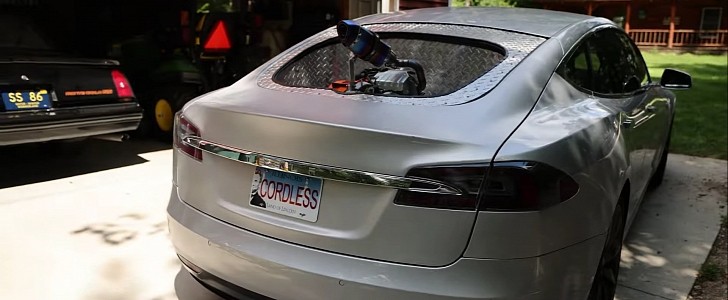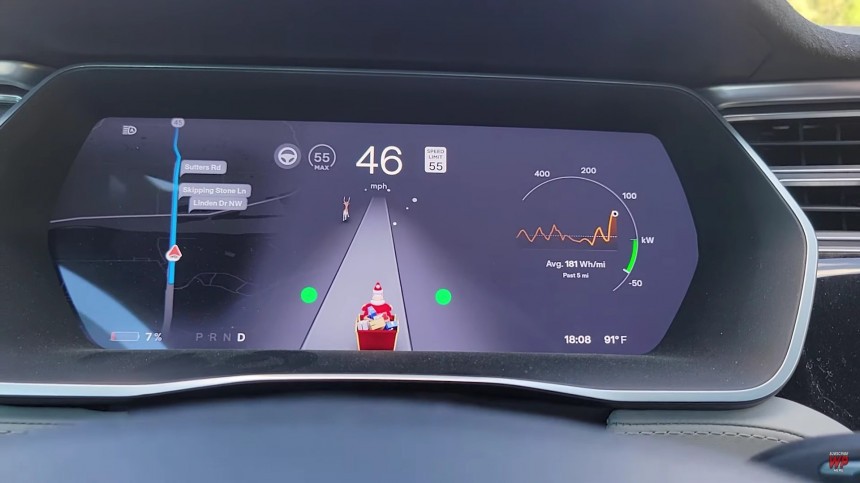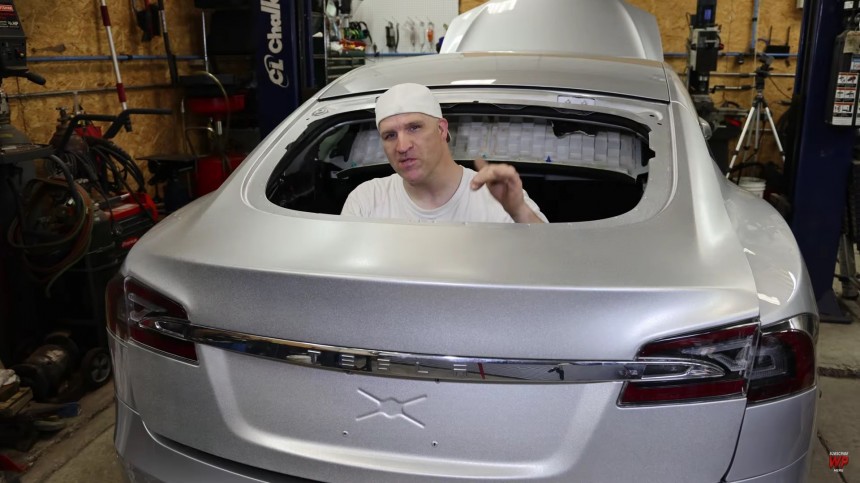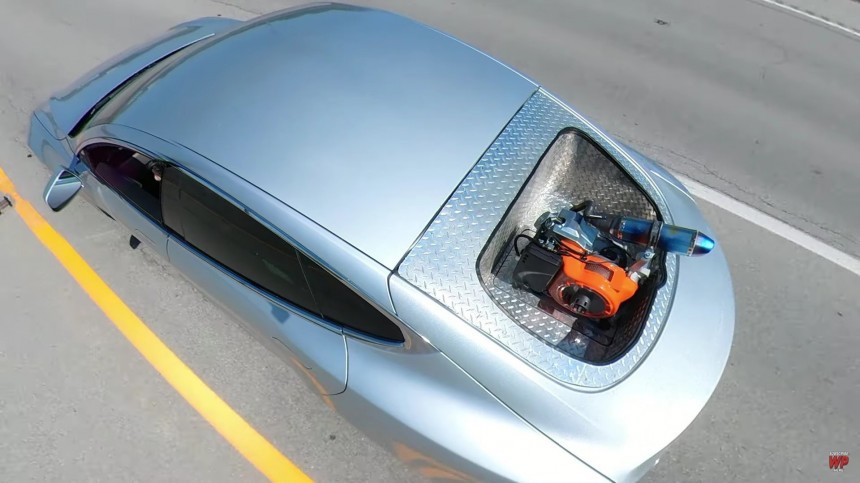According to the builder, the famous YouTuber Matt Mikka from Warped Perception, the project took about eighteen months to complete (and that's only the execution stage). While the video only briefly summarizes the controversial Tesla road trip, the vlogger announced that an improved design is underway.
The idea behind this enterprise was to cover at least 1,500 miles (2,414 km) without stopping at chargers (be they super or regular). Of course, since Tesla didn't set new battery-efficiency records in terms of storage capacity, the Youtuber's Model S had to be modified to suit the purpose. Due to several reasons, the prototype gasoline-powered Tesla S only managed a 24-mpg fuel efficiency.
While several options were considered in the early stages of development – including solar – the choice fell on a single-cylinder, 24.4-CID (400 CCs) engine that would power the Tesla on the move and while stationary. At this point, a vital mention needs to be put on the table: a standard Tesla can not charge while moving. However, Matt modified his Model S so the car could drive and charge simultaneously.
The hybrid propulsion idea is far from new, but a 1,000 hp all-wheel-drive hybrid is the latest twist to the old plot of self-charging electric-driven vehicles. That's one reason the build alone took close to a year, according to the project's author. The video shows a few moments from the 1,800-mile-long road trip (2,900 km). The most striking feature is immediately apparent: the ICE, strapped in the exposed trunk, is ridiculously noisy (the driver and his companion wore protective gear to save their eardrums for future adventures). Play the second video for an audio sample of this one-off Tesla.
The second striking oddity is the flaming exhaust – the ICE ran for almost a week without stopping, and for a considerable portion of that time, it went full-throttle (hence a very low mileage – 24 mpg, or 9.8 liters/100 km). Considering the car had to stay within 45 mph – 72 kph – for the battery to charge while driving, the question of efficiency makes more sense.
The prototype builder shares little technical details at this stage. Matt repeatedly stated his reasons for this, answering YouTube comments to his video: "I know I really wanted to show everything, but there were a couple of reasons I didn't, first off, it was not easy. It took me almost a year to get the system to work perfectly. Second, I had to have everything custom-built, working with the engineers overseas, I had to rip apart the entire high-voltage system in the car, which nobody's going to do unless they have big balls.
And last but not least, this is my first version of the project; I have to first finish my other versions, file my patents, and then I can reveal how I made it work. It was not simple, it was not easy, and it was not safe for sure. But now it is, and it works flawlessly. Just have to perfect it now."
However, this technology demonstrator/test mule Tesla S proved a point – there is an alternative to the present scarcity of charging stations across the US. After all, it drove 1,842 miles (2,964 kilometers) without having to plug in for a recharge. Sure, the engine noise is deafening – it's a mystery how nobody complained about the loud engine rumbling electricity into the car's batteries – but this can easily be improved.
The second stage of this design is to replace the small ICE with a more efficient generator. Matt states that there are six more videos on the way about his much more efficient ICE-charged Tesla S. This will be a Diesel solution since there is no better option (for now): "I would have loved to do solar; the problem is it's not nearly enough energy. My goal is to be able to fill up and just drive Non-Stop for 1500 miles straight, Non-Stop at 75 mph, and a 1,000-horsepower all-wheel-drive car. If I build the proper diesel power plant, I have a feeling that mileage will be through the roof."
How much through the roof exactly is unspecified, but it's "way more than 40 miles per gallon" (5.9 l/100km). Still, if we add to the already complicated equation the fact that this Tesla is all-wheel-drive, has 1,000 hp, five seats, and scores 2.3 seconds in the 0-60mph run (0-97kph), the current 24 mpg (9.8 l/100km) efficiency is not at all outrageous. After all, any other car with those specs is either prohibitively expensive or burns dead dinosaur essence like there's no tomorrow.
While the project is promising in many ways, the video reveals some important crucial lessons. First, a larger-displacement generator is needed to spark up the Tesla S batteries to full potential – meaning maximum power and maximum efficiency simultaneously. But this project - already seven years long since Matt Mikka got the initial idea – made it past phase one testing and proved that there is a bypass for the gruesome issue of the charging grid.
In Matt's own words, "No matter how you paint it, stopping to charge sucks; it's not like there are chargers right at rest stops on the freeway, you have to go off route, go way out of your way, hope that the charger works, hope that the charger is fast because not all of them are, it's a lot of uncertainty. The second one I'm building now is going to be insane and possibly more efficient than supercharging and cheaper."
Apart from the sheer contrariety that this gasoline-hungry Tesla S stands for, the project also raised a few eyebrows from the YouTube community. They pointed out that "this kind of thing would be illegal to drive in most other countries as it would have illegal emissions, illegal fuel storage, passed no crash tests, and a potential danger to anyone who rear-ended it."
But, as you can see from the video, there were no legal issues whatsoever about the design. The highway patrol that pulled over the Tesla inquired only about the slower-than-traffic speed of the hybrid. And this particular issue is something to be solved in the next development phase.
The YouTuber has bigger plans for his car after completing a long road trip without stopping to plug in his vehicle. At the end of the video, you can see his detailed itinerary, fuel efficiency, and other particulars about the "cordless Tesla."
While several options were considered in the early stages of development – including solar – the choice fell on a single-cylinder, 24.4-CID (400 CCs) engine that would power the Tesla on the move and while stationary. At this point, a vital mention needs to be put on the table: a standard Tesla can not charge while moving. However, Matt modified his Model S so the car could drive and charge simultaneously.
The hybrid propulsion idea is far from new, but a 1,000 hp all-wheel-drive hybrid is the latest twist to the old plot of self-charging electric-driven vehicles. That's one reason the build alone took close to a year, according to the project's author. The video shows a few moments from the 1,800-mile-long road trip (2,900 km). The most striking feature is immediately apparent: the ICE, strapped in the exposed trunk, is ridiculously noisy (the driver and his companion wore protective gear to save their eardrums for future adventures). Play the second video for an audio sample of this one-off Tesla.
The second striking oddity is the flaming exhaust – the ICE ran for almost a week without stopping, and for a considerable portion of that time, it went full-throttle (hence a very low mileage – 24 mpg, or 9.8 liters/100 km). Considering the car had to stay within 45 mph – 72 kph – for the battery to charge while driving, the question of efficiency makes more sense.
And last but not least, this is my first version of the project; I have to first finish my other versions, file my patents, and then I can reveal how I made it work. It was not simple, it was not easy, and it was not safe for sure. But now it is, and it works flawlessly. Just have to perfect it now."
However, this technology demonstrator/test mule Tesla S proved a point – there is an alternative to the present scarcity of charging stations across the US. After all, it drove 1,842 miles (2,964 kilometers) without having to plug in for a recharge. Sure, the engine noise is deafening – it's a mystery how nobody complained about the loud engine rumbling electricity into the car's batteries – but this can easily be improved.
The second stage of this design is to replace the small ICE with a more efficient generator. Matt states that there are six more videos on the way about his much more efficient ICE-charged Tesla S. This will be a Diesel solution since there is no better option (for now): "I would have loved to do solar; the problem is it's not nearly enough energy. My goal is to be able to fill up and just drive Non-Stop for 1500 miles straight, Non-Stop at 75 mph, and a 1,000-horsepower all-wheel-drive car. If I build the proper diesel power plant, I have a feeling that mileage will be through the roof."
While the project is promising in many ways, the video reveals some important crucial lessons. First, a larger-displacement generator is needed to spark up the Tesla S batteries to full potential – meaning maximum power and maximum efficiency simultaneously. But this project - already seven years long since Matt Mikka got the initial idea – made it past phase one testing and proved that there is a bypass for the gruesome issue of the charging grid.
In Matt's own words, "No matter how you paint it, stopping to charge sucks; it's not like there are chargers right at rest stops on the freeway, you have to go off route, go way out of your way, hope that the charger works, hope that the charger is fast because not all of them are, it's a lot of uncertainty. The second one I'm building now is going to be insane and possibly more efficient than supercharging and cheaper."
Apart from the sheer contrariety that this gasoline-hungry Tesla S stands for, the project also raised a few eyebrows from the YouTube community. They pointed out that "this kind of thing would be illegal to drive in most other countries as it would have illegal emissions, illegal fuel storage, passed no crash tests, and a potential danger to anyone who rear-ended it."
But, as you can see from the video, there were no legal issues whatsoever about the design. The highway patrol that pulled over the Tesla inquired only about the slower-than-traffic speed of the hybrid. And this particular issue is something to be solved in the next development phase.
The YouTuber has bigger plans for his car after completing a long road trip without stopping to plug in his vehicle. At the end of the video, you can see his detailed itinerary, fuel efficiency, and other particulars about the "cordless Tesla."








































